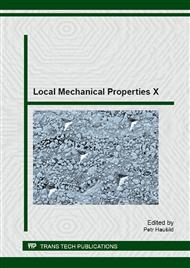[1]
A. Arora, D. B. Marshall, B. R. Lawn, M. V. Swain, Indentation deformation/fracture of normal and anomalous glasses, J. Non. Cryst. Solids 31 (1979) 415-428.
DOI: 10.1016/0022-3093(79)90154-6
Google Scholar
[2]
V. le Houérou, J. -C. Sangleboeuf, S. Dériano, T. Rouxel, G. Duisit, Surface damage of soda- lime-silica glasses: indentation scratch behavior, J. Non. Cryst. Solids 316 (2003) 54-63.
DOI: 10.1016/s0022-3093(02)01937-3
Google Scholar
[3]
D. M. Marsh, Plastic Flow and Fracture of Glass, Proc. R. Soc. A Math. Phys. Eng. Sci. 282 (1964) 33-43.
Google Scholar
[4]
F. M. Ernsberger, Role of Densification in Deformation of Glasses Under Point Loading, J. Am. Ceram. Soc. 51 (1968) 545-547.
DOI: 10.1111/j.1151-2916.1968.tb13318.x
Google Scholar
[5]
K. Peter, Densification and flow phenomena of glass in indentation experiments, J. Non. Cryst. Solids 5 (1970) 103-115.
DOI: 10.1016/0022-3093(70)90188-2
Google Scholar
[6]
H. Ji,V. Keryvin, T. Rouxel, T. Hammouda, Densification ofwindowglass under very high pressure and its relevance to Vickers indentation, Scr. Mater. 55 (2006) 1159-1162.
DOI: 10.1016/j.scriptamat.2006.08.038
Google Scholar
[7]
T. Rouxel, H. Ji, V. Keryvin, T. Hammouda, S. Yoshida, Poisson's Ratio and the Glass Network Topology - Relevance to High Pressure Densification and Indentation Behavior, Adv. Mater. Res. 39-40 (2008) 137-146.
DOI: 10.4028/www.scientific.net/amr.39-40.137
Google Scholar
[8]
M. Imaoka, I. Yasui, Finite element analysis of indentation on glass, J. Non. Cryst. Solids 22 (1976) 315-329.
DOI: 10.1016/0022-3093(76)90062-4
Google Scholar
[9]
I. Yasui, M. Imaoka, Finite element analysis of identation on glass(II), J. Non. Cryst. Solids 50 (1982) 219-232.
DOI: 10.1016/0022-3093(82)90269-1
Google Scholar
[10]
J. C. Lambropoulos, S. Xu, T. Fang, Constitutive Law for the Densification of Fused Silica, with Applications in Polishing and Microgrinding, J. Am. Ceram. Soc. 79 (1996) 1441-1452.
DOI: 10.1111/j.1151-2916.1996.tb08748.x
Google Scholar
[11]
K. Xin, J. C. Lambropoulos, Densification of Fused Silica : Effects on Nanoindentation, in: A. J. Marker III, E. G. Arthurs (Eds. ), Inorg. Opt. Mater. II. SPIE, vol. 4102 (2000) 112-121.
DOI: 10.1117/12.405275
Google Scholar
[12]
G. Kermouche, E. Barthel, D. Vandembroucq, P. Dubujet, Mechanical modelling of indentationinduced densification in amorphous silica, Acta Mater. 56 (2008) 3222-3228.
DOI: 10.1016/j.actamat.2008.03.010
Google Scholar
[13]
V. Keryvin, Indentation as a probe for pressure sensitivity of metallic glasses., J. Phys. Condens. Matter 20 (2008) 114119.
DOI: 10.1088/0953-8984/20/11/114119
Google Scholar
[14]
K. E. Prasad, V. Keryvin, U. Ramamurty, Pressure sensitive flow and constraint factor in amorphous materials below glass transition, J. Mater. Res. 24 (2009) 865-872.
DOI: 10.1557/jmr.2009.0113
Google Scholar
[15]
V. Keryvin, J. -X. Meng, S. Gicquel, J. -P. Guin, L. Charleux, J. -C. Sangleboeuf, P. Pilvin, T. Rouxel, G. Le Quilliec, Constitutivemodeling of the densification process in silica glass under hydrostatic compression, Acta Mater. 62 (2014).
DOI: 10.1016/j.actamat.2013.07.067
Google Scholar
[16]
T. Sato, N. Funamori, Sixfold-Coordinated Amorphous Polymorph of SiO2 under High Pressure, Phys. Rev. Lett. 101 (2008) 255502.
DOI: 10.1103/physrevlett.101.255502
Google Scholar
[17]
D. Wakabayashi, N. Funamori, T. Sato, T. Taniguchi, Compression behavior of densified SiO2 glass, Phys. Rev. B 84 (2011) 144103.
Google Scholar
[18]
C. R. Kurkjian, G. W. Kammlott, M. M. Chaudhri, Indentation Behavior of Soda-Lime Silica Glass, Fused Silica, and Single-Crystal Quartz at Liquid Nitrogen Temperature, J. Am. Ceram. Soc. 78 (1995) 737-744.
DOI: 10.1111/j.1151-2916.1995.tb08241.x
Google Scholar
[19]
C. Bernard, V. Keryvin, J. -C. Sangleoeuf, T. Rouxel, Indentation creep of window glass around glass transition, Mech. Mater. 42 (2010) 196-206.
DOI: 10.1016/j.mechmat.2009.11.008
Google Scholar
[20]
A. Perriot, D. Vandembroucq, E. Barthel, V. Martinez, L. Grosvalet, C. Martinet, B. Champagnon, Raman Microspectroscopic Characterization of Amorphous Silica Plastic Behavior, J. Am. Ceram. Soc. 89 (2006) 596-601.
DOI: 10.1111/j.1551-2916.2005.00747.x
Google Scholar
[21]
S. Yoshida, J. -C. Sangleboeuf, T. Rouxel, Quantitative evaluation of indentation-induced densification in glass, J. Mater. Res. 20 (2005) 3404-3412.
DOI: 10.1557/jmr.2005.0418
Google Scholar
[22]
B. Mantisi, A. Tanguy, G. Kermouche, E. Barthel, Atomistic response of a model silica glass under shear and pressure, Eur. Phys. J. B 85 (2012) 304.
DOI: 10.1140/epjb/e2012-30317-6
Google Scholar
[23]
Y. -F. Niu, K. Han, J. -P. Guin, Locally enhanced dissolution rate as a probe for nanocontactinduced densification in oxide glasses., Langmuir 28 (2012) 10733-40.
DOI: 10.1021/la300972j
Google Scholar


